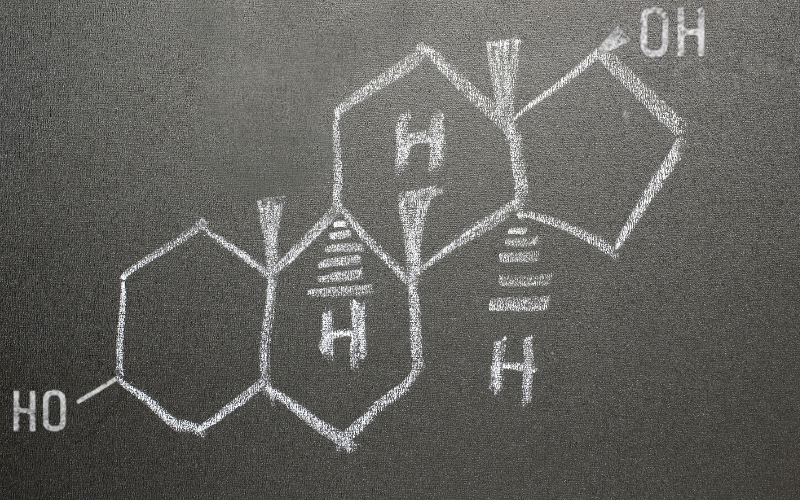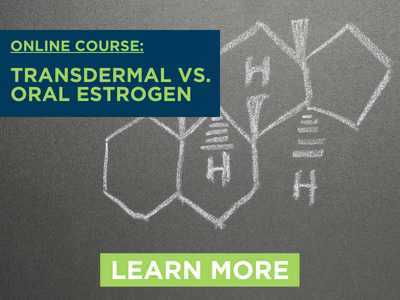
Transdermal vs. Oral Estrogen

While experts agree estrogen has far reaching benefits in menopausal women, researchers tend to disagree on how estrogen therapy should be administered.
If you are interested in learning more about the value and efficacy of Bioidentical hormones in HRT as an alternative to medication-based therapies, please consider our four part hormone optimization workshop series.
Is Transdermal “Less Risky?”
The current trend is to prescribe transdermal estrogen cream. Why do some physicians choose transdermal instead of oral estrogen therapy? Many are worried about the health risks associated with oral estrogen. These concerns were initiated by the Women’s Health Initiative that found oral estrogen increases the risk of myocardial infarction, stroke and blood clots in menopausal women. Therefore, transdermal estrogen is commonly prescribed in lower doses to avoid the damaging atherosclerotic effects of oral conjugated equine estrogen (CEE). Furthermore, it is applied topically and absorbed through the skin. This route of administration bypasses the liver and directly enters the bloodstream to prevent circulatory risks.
What about the benefits of Oral Estrogen?
Transdermal estrogen may seem like a better choice for estrogen therapy, but oral estrogen offers more cardiovascular benefits. In fact, many studies claim transdermal estrogen does not provide any cardiovascular protection. It is estimated that 50-75% of estrogen’s benefits are on LDL and HDL cholesterol, fibrinogen, and fatty acid esters, because oral estrogen passes through the liver to improve cholesterol health. Since transdermal estrogen bypasses the liver to directly enter the bloodstream, it cannot provide advantageous lipid effects. To prevent a large majority of women from succumbing to coronary artery and cardiovascular disease, it is sensible to prescribe an oral estrogen therapy for maximum cardiovascular protection.
A safer and effective form of oral estrogen
Hormone educator, Dr. Neal Rouzier states that “the medical literature does not support the use of creams and patches over oral bioidentical estrogen. Oral estrogen is far better at protecting women against cardiovascular problems as many studies show a significantly reduced incidence of both heart attacks and strokes with the use of oral as compared to the use of transdermal estrogen creams or patches. Transdermal estrogen has only a minimal effect on improving blood lipids (good and bad cholesterol and blood fats) — whereas oral estrogen has a much stronger value in doing this. Many medical studies have demonstrated that oral estrogen’s effect on total cholesterol, LDL and HDL-cholesterol provide greater overall protection, whereas transdermal provides much less protection and therefore they provide less cardiovascular protection in the long run. The patch and transdermal creams are not entirely without value. There are a few women with certain types health histories, where oral estrogen is contraindicated and transdermal estrogen replacement may be appropriately recommended. However, this is not the case for the great majority of women. Oral estrogen have many more health protective benefits than does transdermal estrogen and therefore the preferred form of estrogen.
When it comes to oral estrogen, medical studies have found that oral e2 estradiol is the safest and most effective form, because it avoids inherent side effects related to oral CEE. The Women’s Estrogen for Stroke Trial (WEST) found oral estradiol was not associated with increased blood clots, but an increase in blood vessel inflammation and clotting was due to ten biologically active estrogens that are in CEE (Premarin). These active estrogens are not found in estradiol.
Conclusion
Prescribing the right form of estrogen should be considered on an individual basis. Older women (age>60) that have never taken oral estrogen are advised to take transdermal estrogen to avoid the risk of myocardial infarction or stroke. Additionally, transdermal estrogen is the best choice for women that have a history of clotting disorders. For women that do not have these established factors, oral estradiol is the best choice for protecting the heart from cardiovascular disease and hypertension risks that increase dramatically in menopausal women.
If you are interested in learning more about the value and efficacy of BHRT as an alternative to medication-based therapies, please consider our four part Hormone Optimization Workshop Series, and start training with us at Part I: Discover the Power of BHRT.
References:
- Billeci AM, Paciaroni M, Caso V, Agnelli G. Hormone replacement therapy and stroke. Curr Vasc Pharmacol. 2008;6(2):112-123.
- Chu MC, Cosper P, Nakhuda GS, Lobo RA. A comparison of oral and transdermal short-term estrogen therapy in postmenopausal women with metabolic syndrome. Fertil Steril. 2006;86:1669-1675.
- Hendrix SL, Wassertheil-Smoller S, Johnson KC, et al. Effects of conjugated equine estrogen on stroke in the Women’s Health Initiative. Circulation. 2006;113:2425– 2434.
- Ho JY, Chen MJ, Sheu WH, Yi YC, Tsai AC, Guu HF, Ho ES. Differential effects of oral conjugated equine estrogen and transdermal estrogen on atherosclerotic vascular disease risk markers and endothelial function in healthy postmenopausal women. Hum Reprod. 2006;21(10):2715-2720.
- Mendelsohn ME, Karas RH. Protective effects of estrogen on the cardiovascular system. N Engl J Med. 1999;340:1801–1811.
- Menon DV, Vongpatanasin W. Effects of transdermal estrogen replacement therapy on cardiovascular risk factors. Treat Endocrinol. 2006;5(1):37-51.
- Nelson HD, Humphrey LL, Hygren P, Teutsch SM, Allan JD. Postmenopausal hormone replacement therapy. Scientific review. JAMA 2002;288:872–881.
- North American Menopause Society. Amended report from the NAMS Advisory Panel on postmenopausal hormone therapy. Menopause. 2003;10:6-12.
- Scarabin PY, et al. Differential association of oral and transdermal oestrogen-replacement therapy with venous thromboembolism risk. Lancet. 2003;362(9382):428–432.
- Smith NL, Heckbert SR, Lemaitre RN, Reiner AP, et al. Esterified estrogens and conjugated equine estrogens and the risk of venous thrombosis. JAMA. 2004 Oct;292(13):1581-1587.
- Vehkavaara S, Silveira A, Hakala-Ala-Pietila T, Virkamaki A, et al. Effects of oral and transdermal estrogen replacement therapy on markers of coagulation, fibrinolysis, inflammation and serum lipids and lipoproteins in postmenopausal women. Thromb Haemost. 2001;85(4):619-625.
- Verhoeven MO, Hemelaar M, Van Der Mooren MJ, Kenemans P, Teerlink T. Oral, more than transdermal, oestrogen therapy lowers asymmetric dimethylarginine in healthy postmenopausal women: a randomized, placebo-controlled study. J Intern Med. 2006;259:199-208.
- Viscoli CM, Brass LM, Kernan WN, Sarrel PM, et al. A clinical trial of estrogen replacement therapy after ischemic stroke. N Engl J Med. 2001;345:1243-1249.
- Vongpatanasin W, et al. Differential Effects of Oral Versus Transdermal Estrogen Replacement Therapy on C-Reactive Protein in Postmenopausal Women . J of Amer Coll Cardio. 2003;41(8):1358–1363.
